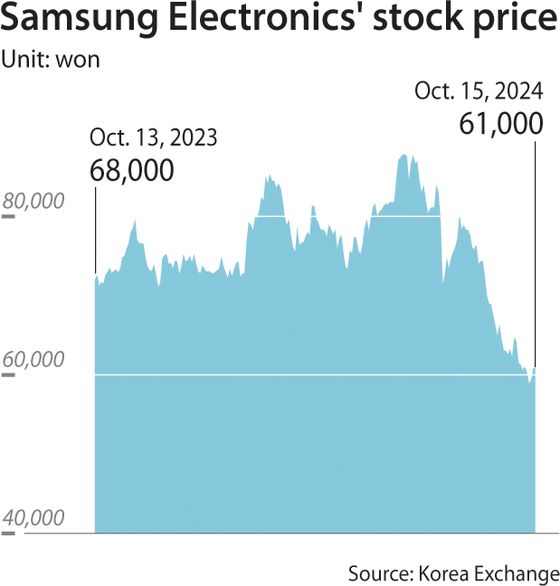From leader to follower: Samsung's agony in the chip battle
Published: 15 Oct. 2024, 18:59
Updated: 15 Oct. 2024, 19:00
-

- JIN EUN-SOO
- jin.eunsoo@joongang.co.kr
Audio report: written by reporters, read by AI
![The Samsung Electronics logo is seen during a media tour of Samsung Electronics' headquarters in Suwon, Gyeonggi, on June 13. [AP/YONHAP]](https://koreajoongangdaily.joins.com/data/photo/2024/10/15/cf317987-7c8f-4711-b113-e5a24171df04.jpg)
The Samsung Electronics logo is seen during a media tour of Samsung Electronics' headquarters in Suwon, Gyeonggi, on June 13. [AP/YONHAP]
Samsung Electronics, a longtime leader in memory chip realm, is on the verge of losing that title, having to fend off fast-chasing Chinese players while playing a hard catch-up with its crosstown rival, SK hynix.
The looming crisis has lead its chip head, Jun Young-hyun, to issue an unprecedented apology after its consensus-missing third quarter preliminary earnings were announced last week, admitting to falling short of market expectations and pledging a complete overhaul of the organization to secure competitiveness.
Samsung's faltering performance in the AI chip realm led its stocks to lose more than 20 percent coming into this year. The price, which went as high as 87,800 won ($64.46) in July on hopes of its premium high bandwidth memory (HBM) receiving a green light from AI chip goliath Nvidia, hit a rock bottom of 58,900 won in early October, entering the 50,000 won range for the first time in nearly two years.
Still, there's no sign that Samsung's latest HBM products will pass the qualification test from Nvidia any time soon, and the speed with which Chinese memory chipmakers expand their market share is getting ever faster.
Samsung's compliance committee, an independent committee monitoring the company's compliance with laws and ethics, admitted that Samsung is fighting a hard game in its annual report issued Tuesday.
“Samsung Electronics is undoubtedly the biggest company in Korea, but is in a difficult situation, having to deal with unpredictably fast-changing economic conditions around the world, an emergence of its first labor union, failing confidence among employees, hardships in recruiting talent and technology leakage,” it said.

Samsung Electronics' leadership in memory chips was significantly dented when it continued failing to supply its HBM chips, the premium memory chip that stacks dynamic random-access memory (DRAM) to empower AI processors, to Nvidia, while its rival, SK hynix, succeeded.
SK hynix is the sole supplier of both HBM3 and HBM3E, the fourth and fifth generation of the type, to Nvidia at the moment, while Samsung is still proceeding with qualification tests.
A slew of advanced technologies is required to make HBM chips, but what's considered a prerequisite is the quality and cost of DRAM which is determined by its yield rate.
“The yield rate for DRAM is quintessential for HBM because if that doesn't live up standards, the cost and processing time of HBM will inevitably deteriorate,” said Park Jea-gun, an electronic engineering professor at Hanyang University.
“After DRAM is qualified, then it comes to which kind of packaging and bonding technology the company will use to determine the performance of HBM.”
Both Samsung Electronics and SK hynix are utilizing 1b nanometer process technology, which is equivalent to a 12-nanometer range, for DRAM that goes into HBM3E.
Yield rates are considered confidential, but Samsung Electronics' 1b nanometer DRAM's yields are said to be significantly lower than those of SK hynix, despite it being the first to mass-produce it in May 2023.
To make matters worse, SK hynix, in August became the first to develop the next generation of DRAM — 1c nanometer nodes, which are equivalent to the 11-nanometer level.
“Samsung Electronics tends to push the bar for better performance, but that consequently leads to lower yield,” said Lee Jong-hwan, a system semiconductor engineering professor at Sangmyung University.
“I think it believes that yields can be improved gradually until the final product gets shipped to clients, but those tactics have turned out to be not that effective now. It means that there needs to be better leadership to find a point where the development team and the manufacturing team can both fulfill.”
Chinese players
If playing catch-up were the only challenge for Samsung, it would be a relief.
But Samsung Electronics is also tasked with fending off Chinese memory chipmakers, which have been striving for several years to achieve chip technology independence as the country's rivalry with the U.S. escalates.
Having to compete with Chinese players was not on Samsung Electronics' agenda before.
Their presence is already chipping into Samsung's earnings as the company acknowledged “increased legacy memory chip supply from Chinese players” as one of the reasons behind its worse-than-expected earnings for the third quarter.
Chinese chipmakers' market share in DRAM market was estimated to be 10.1 percent in the third quarter of next year, up from six percent this year, according to data TrendForce released Monday.
ChangXin Memory Technologies' DRAM output this year was estimated to surpass 10 percent in a recent Morgan Stanley report, forecasting that Chinese players' invasion of the legacy DRAM market will happen even faster.
Although its main products rely on a 17-nanometer process, its technological advancement is expected to accelerate considering that its main products last year focused on 19-nanometer process.
“Chinese players are relying on the domestic market at the moment because they cannot make inroads to western markets, but that cannot be guaranteed forever,” Hwang Cheol-seong, a materials science and engineering professor at Seoul National University, said at a recent forum.
BY JIN EUN-SOO [jin.eunsoo@joongang.co.kr]










with the Korea JoongAng Daily
To write comments, please log in to one of the accounts.
Standards Board Policy (0/250자)